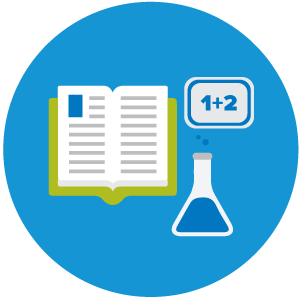-
 Science
ScienceResources and Activities below are organized by grade level and content area. Required resources and guiding questions are included.
9 - 12 Chemical Reactions on Youtube
-
 Newton's Laws (Physical Science)
Newton's Laws (Physical Science)Grades 6 - 8 Activity How can you explain and predict interactions between objects?
Resources Needed
- Discovery Education Techbook (iPad App, free)
1. Visit spps.discoveryeducation.com (be sure to put the spps first!)
2. Log in with Student ID Number (sXXXXXX) and Password
3. In the left side menu, choose Discovery Techbook.
4. Change the grade level to Grade 6.
5. Select the Force and Motion Unit and work through the first 3 concepts (Interaction of Force & Mass, Newton's Laws, and Friction)
-
 Force & Motion (Physical Science)
Force & Motion (Physical Science)Grades 6 - 8 Activity How do forces affect motion?
Resources Needed
- PhET (Website, free)
1. Visit the PhET simulation at https://phet.colorado.edu/sims/html/forces-and-motion-basics/latest/forces-and-motion-basics_en.html
2. Explore the first 3 interactives about Net Force, Motion, and Friction
3. What did you learn about how the sum of forces can affect motion?
4. What did you discover about how friction affects motion?
5. Extension - explore the last interactive about Acceleration
-
Grades 6 - 8 Activity How does my body work?
Resources Needed
- DKFindout (Website, free)
1. Go to https://www.dkfindout.com/us/human-body/
2. Select 4 different topics to explore and complete the quiz
-
Grades 6 - 8 Activity How does an organ in the human body affect how the body works?
Resources Needed
- OrganTrail (Website, free)
Follow the directions given to produce a poster on an organ of the human body. It is your choice as to what organ you want to research.
-
Grades 6 - 8 Activity What happens when ocean currents and air masses interact?
Resources Needed
- Science Education Center Weather Lab (Website, free)
1. Visit the Smithsonian Science Education Center's Weather Lab App at https://ssec.si.edu/weather-lab
2. Read the directions at the bottom of the screen
3. Run the simulation at least 4 times.
4. What are some ways that air masses different from each other?
5. What are some different ways that air masses and ocean currents can interact?
6. What happens when two Tropical air masses (mTropical and cTropical) interact with the Pacific Ocen Gyre current?
7. How did you do with your predictions? Were you able to improve your chances of predicting the outcome of the interactions?
-
 Predicting Weather (Earth Science)
Predicting Weather (Earth Science)Grades 6 - 8 Activity How does a meteorologist predict the weather?
Resources Needed
- DiscoveryEducation (Website, free)
1. Watch the virtual field trip video featuring meteorologists from The Weather Channel. (approx 60 min.)
2. What are some of the factors meteorologists consider when they predict the weather?
3. What are 5 questions you would ask the meteorologists in this video about their jobs or about the weather?
-
 How Fast Am I Going? (Physical Science)
How Fast Am I Going? (Physical Science)Grades 9 - 12 Activity What are the ways can I measure movement?
Resources Needed
- BBC Education (Website, free)
Read pages 1-5 on the website and answer the questions about Motion found there. Click on reveal answer to check your answer. Students who want a challenge can try page 6
-
 Can you wave at me? (Physical Science)
Can you wave at me? (Physical Science)Grades 9 - 12 Activity What can I do to make waves move differently?
Resources Needed
- PhET (Website, free)
Open the Phet simulation, waves on a string. In the manual mode (box on top left of screen) move the wrench to explore waves. Adjust the tension and record what happens. Then adjust the dampening and record what happens. Tie a string to a door knob or table leg and pluck it while it is pulled tight and loose. Note the pitch the string makes and compare that to what was seen in the simulation.
Use the Osilation and Pulse settings to explore how changing the frequeny and amplitude settings affects the wave. Write a definition of wave frequency and amplitude. Research how these impact what we hear.
-
 Survival of the Sneakiest (Biology)
Survival of the Sneakiest (Biology)Grades 9 - 12 Activity What makes an organisms "fit"?
Resources Needed
- Berkely University (Website, free)
Read the comic "Survival of the Sneakiest" and answer the discussion questions.
-
Grades 9 - 12 Activity How have humans adapted and evolved?
Resources Needed
- Click and Learn (iPad App, free)
1. Go to the box labeled Recent Adaptations in 'Humans' & read key concepts
2. Read and watch videos on pages 2-8
3. Select 1 example of a Human Adaptation on page 8
4. Read the information and watch the videos about the adaptation.
5. Write a summary about how that adaptation came about.
6. Read through pages 9-15
-
 Chemical Reactions on YouTube (Chemistry)
Chemical Reactions on YouTube (Chemistry)Grades 9 - 12 Activity How do chemical reactions occur?
Resources Needed
- http://bit.ly/2BN5FVq (Website, free)
1. Download the worksheet at http://bit.ly/2BN5FVq into Notability.
2. Watch the videos referenced on the worksheet and answer the questions.
-
 Balancing Chemical Reactions (Chemistry)
Balancing Chemical Reactions (Chemistry)Grades 9 - 12 Activity How do I know if a chemical reaction is balanced?
Resources Needed
- PhET (Website, free)
1.Visit the Phet website at https://phet.colorado.edu/en/simulation/balancing-chemical-equations
2. Download Balancing Chemical Equations
3. Complete all three parts of the Introduction
4. Go to Game
5. Complete all three levels of the game
Extension: Go back and try to beat previous score in the game
-
Grades 9 - 12 Activity What can I do to make waves move differently?
Resources Needed
- Crack the Circuit (Website, free)
Build all 18 circuits
Identify which are series and which are parallel and explain why.
-
Grades 9 - 12 Activity How can I get more electrical current? (Ohm's Law)
Resources Needed
- PhET (Website, free)
Open the Phet Simulation, Ohm's Law. Add and takeaway batteries to the circut by moving the Voltage slide and note the what happens to the amount of current. The current is measured in milliamperes (a thousandth of an ampere, mA) and can be found in the box in the middle of the circut. Now adjust the resistance in the circut and note how the current changes. Write a statement showing how both voltage and resistance affect current. Use the similation to explain Ohm's law to a friend or someone in your house.




